The Conductivity of Combined Acid and Hydraulic Fracturing in the Fractured Tight Sandstone Reservoir: An Experimental Study
Abstract
1. Introduction
1.1. Field Background
1.2. Application of Acid in Sandstone Reservoirs
2. Experimental Design
2.1. Experimental Device
2.2. Experimental Material
- (1)
- Rock sample
- (2)
- Proppant
- (3)
- Liquid material
2.3. Experimental Method and Scheme
2.3.1. Experimental Method
- (1)
- Stimulation techniques in artificial fractures
- 1.
- Acid fracturing
- 2.
- Acid and sand support composite stimulation technique
- (2)
- Acid etching simulation experiment in natural fractures
2.3.2. Experimental Scheme
- (1)
- Artificial fractures
- (2)
- Natural fractures
3. Results and Discussion
3.1. Artificial Fractures
3.2. Natural Branch Fracture
3.3. Characteristics of the Conductivity of Main Fractures and Branch Fractures
4. Conclusions
- (1)
- Composite stimulation of acid and sand support could significantly improve the conductivity of the artificial fractures. When the sand concentration is 2 kg/m2, the sand fracturing and subsequent acidizing could increase the fracture conductivity to 8 times that of the sand-supported fractures. The acid fracturing and subsequent sand support could increase the fracture conductivity to 2.5 times that of the sand-supported fracture.
- (2)
- Acid fracturing and subsequent sand support can increase the fracture width, thus increasing the sand concentration. When the sand concentration reaches 3 kg/m2, the fracture conductivity is 1.2 times that of the fractures in the sand fracturing and subsequent acidizing. When the sand concentration reaches 4 kg/m2, the fracture conductivity is 1.3 times that of the fractures in the sand fracturing and subsequent acidizing.
- (3)
- The composite stimulation of acid fracturing and subsequent sand support is an effective means to improve the conductivity of natural fractures. After being dissolved by the acid, the maximum sand concentration of the 70/140 mesh ceramsite proppants for the natural fractures can reach 2 kg/m2. The fracture conductivity remains at 4.2 D·cm under 40 MPa. Under the same conditions, the conductivity of the acid-etched fractures almost disappears.
- (4)
- In reservoirs with richly developed natural fractures, the acid fracturing and subsequent sand support have a better effect in terms of improving the fracture system conductivity. When the sand concentration is 4 kg/m2, the conductivity of the fracture system reaches 3.5 times the conductivity when the sand concentration is 2 kg/m2 and is 2.8 times that of the fractures in the sand fracturing and subsequent acidizing.
5. Future Works
- (1)
- The rock breaking and fracture propagation of the reservoir in composite fracturing are also important research directions in reservoir stimulation. Subsequently, the influence of the three-directional principal stress of the reservoir on the rock breaking and fracture propagation behavior in composite fracturing can be studied through triaxial mechanical experiments.
- (2)
- The optimization methods of acid systems, pumping procedures, and treatment parameters are essential to clarifying the improvement laws of each parameter on the main fractures, natural fractures, and the fracture network.
- (3)
- The research on the applicability of composite stimulation in multiple types of reservoirs can be expanded; the retention performance of the fracture conductivity of composite stimulation should be evaluated under different reservoir conditions; and the applicability of the process can be further improved.
- (4)
- Based on clarifying the production-increasing mechanism of the composite stimulation, the relevant model needs to be established to determine, on the engineering scale, how much the production-increasing capacity of the composite stimulation has improved compared with hydraulic fracturing.
Author Contributions
Funding
Data Availability Statement
Conflicts of Interest
References
- Wang, Q.; Zhang, H.; Xu, K.; Yuan, F.; Yin, G.; Wang, H. Key Geomechanical Issues in Efficient Development of Ultra Deep Oil and Gas. In Proceedings of the International Petroleum Technology Conference, Kuala Lumpur, Malaysia, 18–20 February 2025. [Google Scholar]
- Liu, Z.; Zhang, Y.; Wu, J.; Zhang, L.; Feng, D.; Zhou, P.; Ge, Q.; Song, M. Multi-Scale Fracture Prediction and Modeling. In Proceedings of the International Petroleum Technology Conference, Kuala Lumpur, Malaysia, 18–20 February 2025. [Google Scholar]
- Wang, J.; Yang, X.; Zhang, J.; Wang, K.; Zhang, R.; Wang, Q.; Ren, B.; Ukar, E. Subsurface Fracture Characterization in a Folded Ultra-deep Tight-gas Sandstone Reservoir: A case study from the Keshen gas field, Tarim Basin, China. J. Struct. Geol. 2023, 172, 104867. [Google Scholar] [CrossRef]
- Wang, Z.; Wang, C.; Xu, K.; Zhang, H.; Chen, N.; Deng, H.; Hu, X.; Yang, Y.; Feng, X.; Du, Y.; et al. Characteristics and Control Factors of Tectonic Fractures of Ultra-deep Tight Sandstone: Case Study of the Lower Cretaceous reservoir in Bozi-Dabei area, Kuqa Depression, Tarim Basin, China. J. Nat. Gas Geosci. 2023, 8, 439–453. [Google Scholar] [CrossRef]
- Liu, J.; Lu, Y.; Luo, Y.; Yang, H.; Lu, L. Method for Predicting the Injection Pressure for Horizontal Wells in Fractured Tight Sandstone Reservoirs. Geophysics 2024, 89, 1JA-V359. [Google Scholar] [CrossRef]
- Wu, B.; Xiao, F.; Kong, M.; Wang, B.; Zhang, S. Research on Proppant Optimization and Field Test of Ultra-Deep Tight Conglomerate Sandstone Reservoir. Front. Energy Res. 2022, 10, 891063. [Google Scholar] [CrossRef]
- Wang, Y.; Zhang, G.; Peng, Y.; Zhang, T. Combined Influences of Acid Solution and Geo-Stress on Fracture Geometry During Acid Fracturing in Laboratory. In Proceedings of the 52nd U.S. Rock Mechanics/Geomechanics Symposium, Seattle, WA, USA, 17–20 June 2018. [Google Scholar]
- Xiao, Y.; Wang, H.; Mi, Z.; Cheng, Y.; Cao, X.; Qu, J.; Guo, J. Laboratory Measurements of Acid-Etched Fracture Conductivity for Medium-High Porosity and Low Permeability Limestone Reservoirs in EE Oil Field. In Proceedings of the 54th U.S. Rock Mechanics/Geomechanics Symposium, Golden, CO, USA, 28 June–1 July 2020. [Google Scholar]
- Gunawan, H.; Susanto, H.; Widyantoro, B.; Noguera, J. Fracture Assisted Sandstone Acidizing, Alternative Approach To Increase Production in Tight Sandstone Reservoir. In Proceedings of the SPE Oil and Gas India Conference and Exhibition, Mumbai, India, 28–30 March 2012. [Google Scholar]
- Rozo, R.; Paez, J.; Mendoza, A.; Milne, A.; Soler, D. Combining Acid- and Hydraulic-Fracturing Technologies Is the Key to Successfully Stimulating the Orito Formation. In Proceedings of the SPE Hydraulic Fracturing Technology Conference, College Station, TX, USA, 29–31 January 2007. [Google Scholar]
- Salazar, F.; Rachid, R.; Jimenez, J.; Milne, A.; Ali, S. Hydraulic Fracturing with Water-Based Fluids in Water-Sensitive Formations. In Proceedings of the SPE European Formation Damage Conference & Exhibition, Noordwijk, The Netherlands, 5–7 June 2013. [Google Scholar]
- Boucher, A.; Del Rio, C.; Salazar, F.; Milne, A.; Robles, M. Increasing Oil Production without Increasing Water Cut in Wells in Ecuador. In Proceedings of the SPE European Formation Damage Conference, Noordwijk, The Netherlands, 7–10 June 2011. [Google Scholar]
- Zhao, H.; Xiong, Y.; Zhen, H.; Liu, C.; Li, X. Experimental Investigation on the Fracture Propagation of Three-stage Acid Fracturing of Tight Sandstone Gas Reservoir. J. Pet. Sci. Eng. 2022, 211, 110143. [Google Scholar] [CrossRef]
- Medavarapu, K.; Das, S.; Ch, S.; Nainwal, S.P. Optimization of Fracturing Technique for Successful Exploitation of Tight Gas Reservoirs of Mandapeta Field. In Proceedings of the SPE Oil and Gas India Conference and Exhibition, Mumbai, India, 4–6 April 2017. [Google Scholar]
- Connolly, P.; Cosgrove, J. Prediction of Fracture-Induced Permeability and Fluid Flow in the Crust Using Experimental Stress Data1. AAPG Bull. 1999, 83, 757–777. [Google Scholar]
- Zhu, P.; Lin, C.; Ren, H.; Zhao, Z.; Zhang, H. Micro-fracture Characteristics of Tight Sandstone Reservoirs and Its Evaluation by Capillary Pressure curves: A Case Study of Permian Sandstones in Ordos Basin, China. J. Nat. Gas Sci. Eng. 2015, 27, 90–97. [Google Scholar] [CrossRef]
- Karazincir, O.; Li, Y.; Williams, W.; Zaki, K.; Rijken, P.; Rickards, A. Impact of Remedial Acid Practices on Proppant Embedment and Fracture Face Permeability. In Proceedings of the SPE Annual Technical Conference and Exhibition, Virtual, 26–29 October 2020. [Google Scholar]
- Gou, B.; Guan, C.; Li, X.; Ren, J.; Zeng, J.; Wu, L.; Guo, J. Acid-etching fracture morphology and conductivity for alternate stages of self-generating acid and gelled acid during acid-fracturing. J. Pet. Sci. Eng. 2021, 200, 108358. [Google Scholar] [CrossRef]
- Liang, X.; Zhou, F.; Liang, T.; Huang, Y.; Wei, D.; Ma, S. The effect of Combined Proppants Upon the Fracture Conductivity in Tight Gas Reservoirs. Energy Rep. 2020, 6, 879–884. [Google Scholar] [CrossRef]
- Shaibu, R.; Guo, B.; Wortman, P.B.; Lee, J. Stress-sensitivity of Fracture Conductivity of Tuscaloosa Marine Shale cores. J. Pet. Sci. Eng. 2022, 210, 110042. [Google Scholar] [CrossRef]
- Guo, J.; Zhan, L.; Gou, B.; Zeng, J.; Zhou, C. Experimental Optimization of Acid System for Acidizing in Mud-damaged Deep Fractured Carbonate Formation. J. Pet. Sci. Eng. 2020, 195, 107639. [Google Scholar] [CrossRef]
- Kong, X.; Liu, B.; Wan, X.; Li, S.; Liu, Z.; Chen, M.; Shen, J. Experimental Evaluation and Optimization of Improved Conductivity of Gelling Acid Etched Fractures in Deep, Low-Permeability Reservoirs. Fuel 2023, 348, 128468. [Google Scholar] [CrossRef]
- Guo, J.; Ren, J.; Wang, S.; Chen, C.; Lai, J.; Gou, B. Comprehensive Study of Fracture Flow Characteristic and Feasibility of Hybrid Volume Stimulation Technique in Tight Fractured Carbonate Gas Reservoir. J. Pet. Sci. Eng. 2019, 174, 362–373. [Google Scholar] [CrossRef]
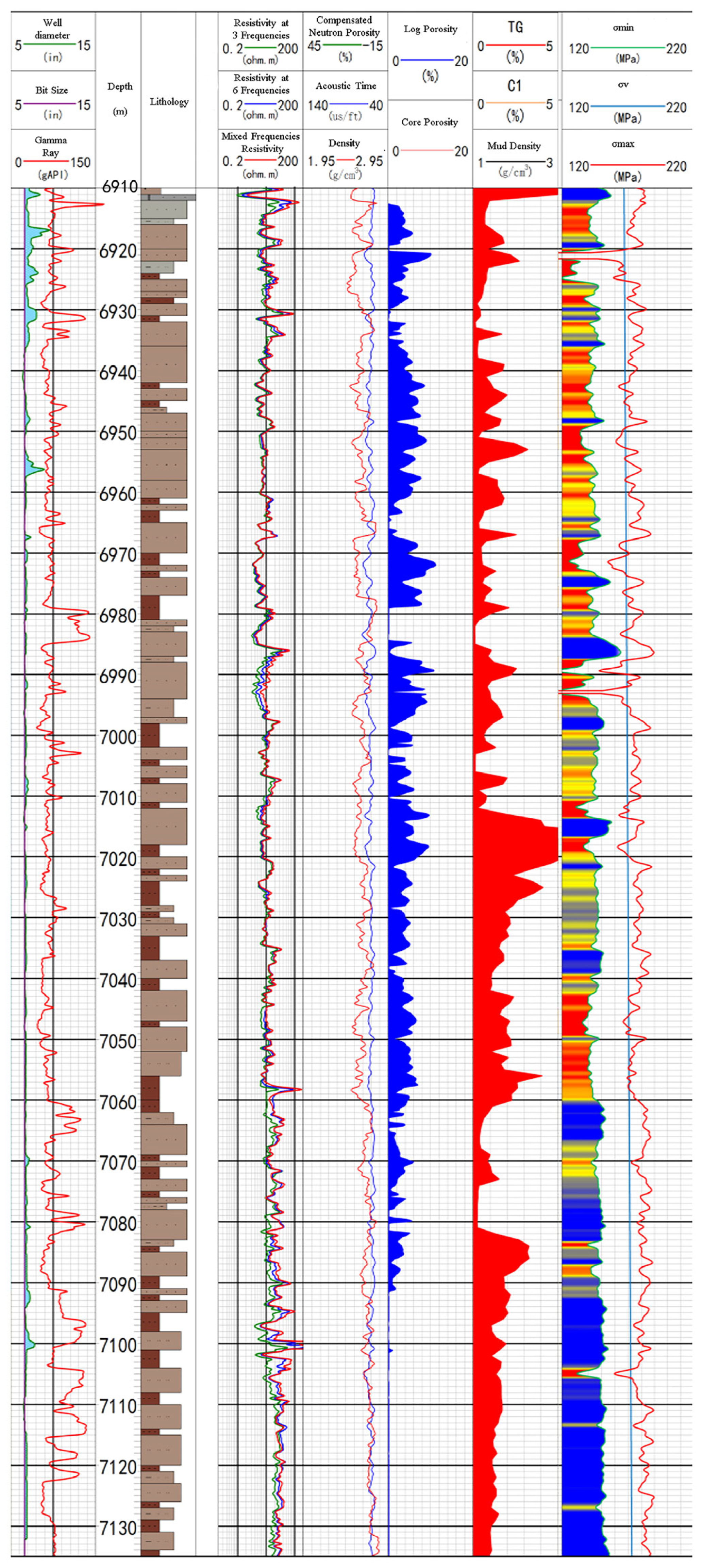

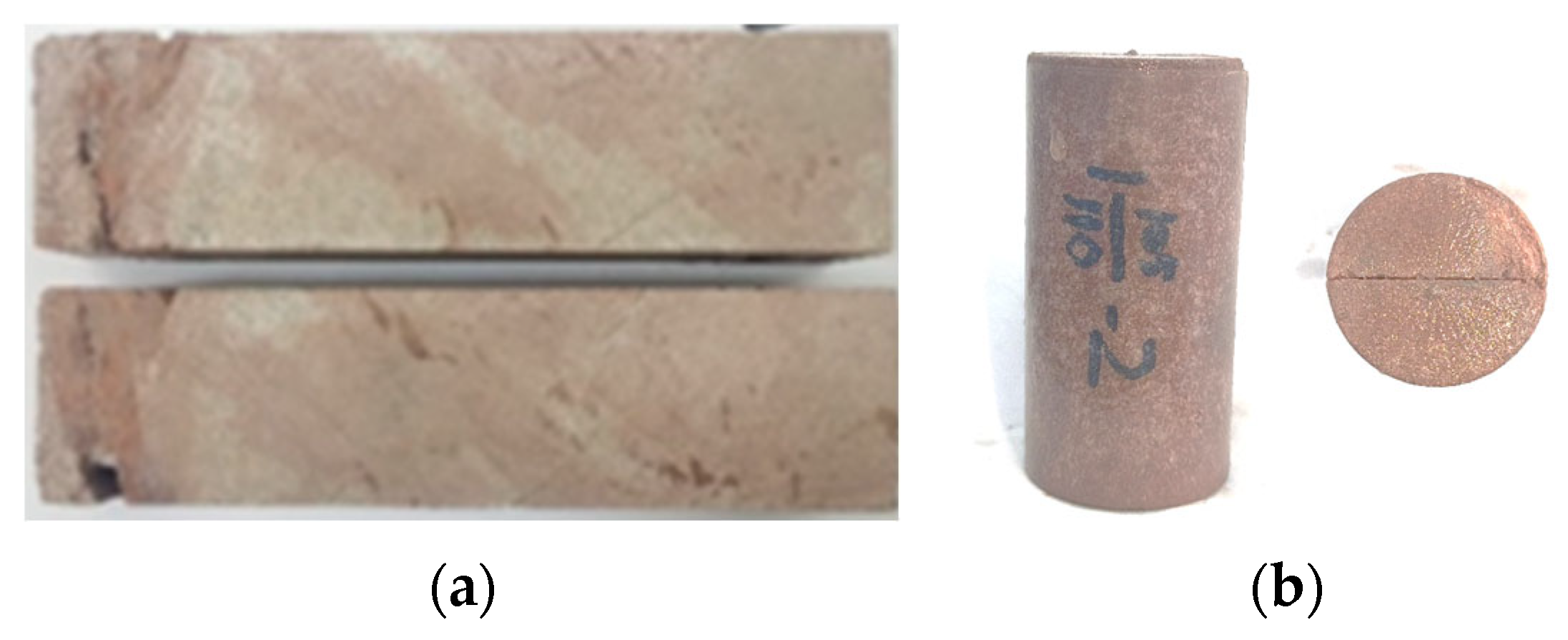
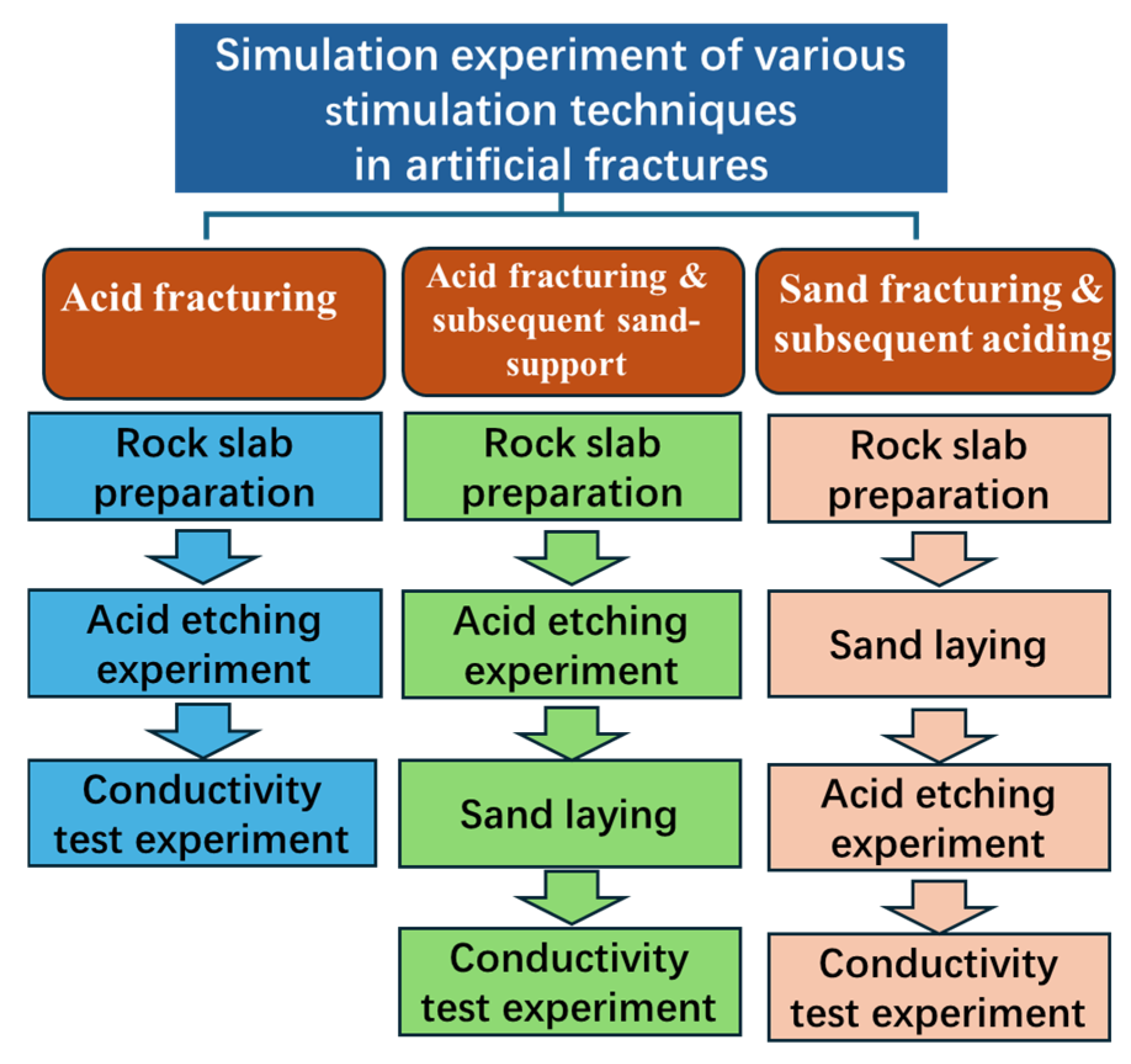
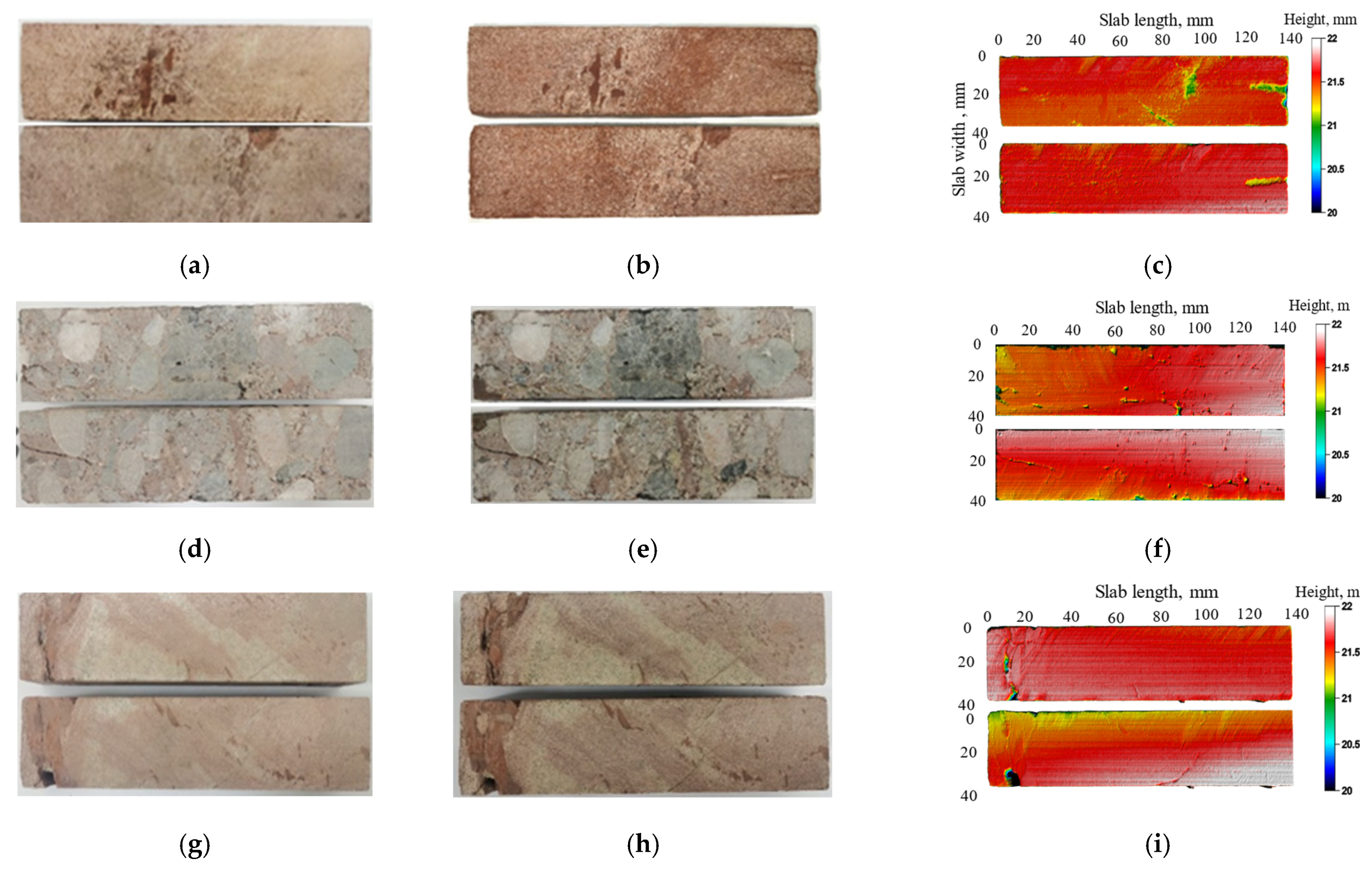
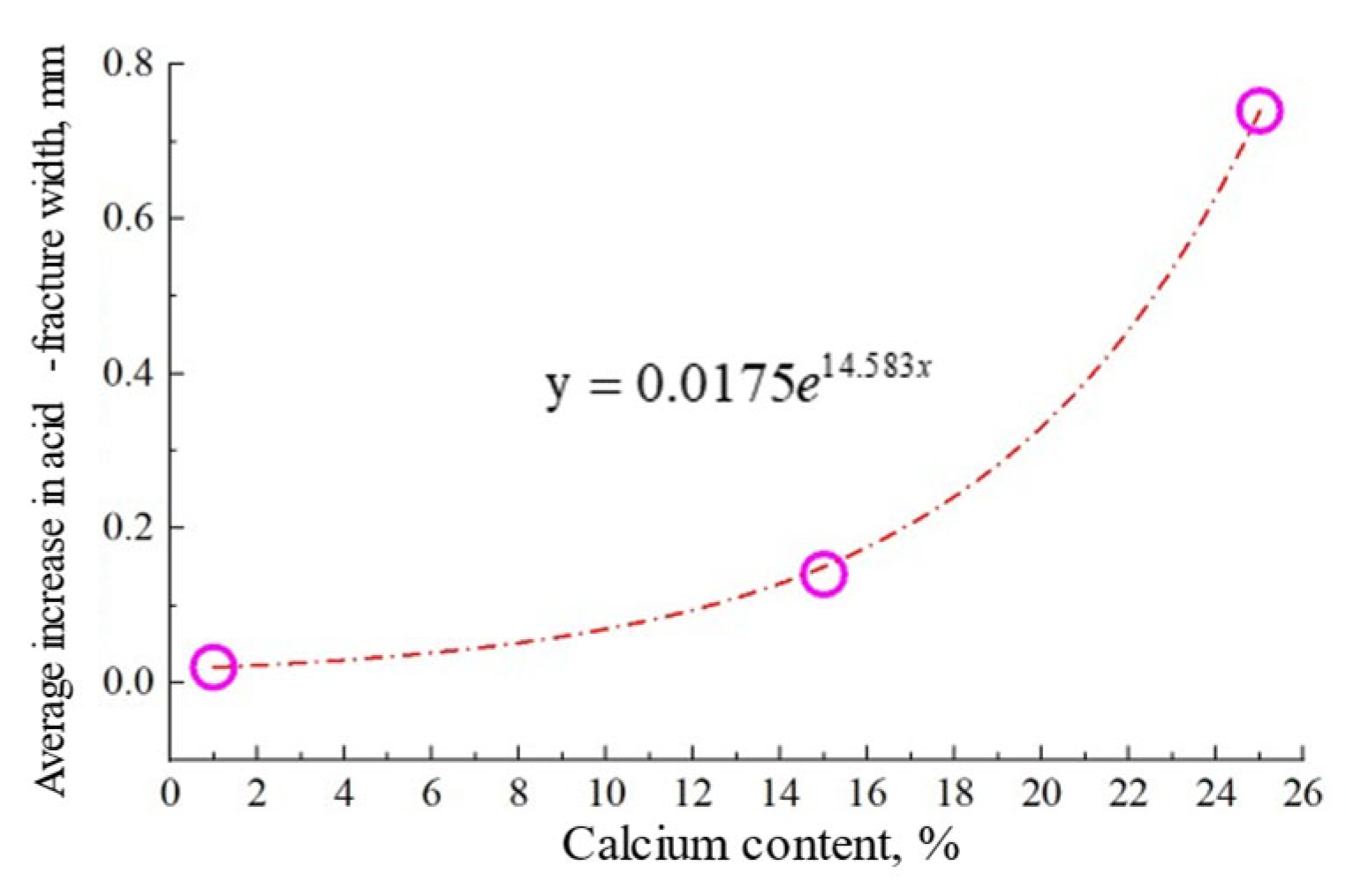
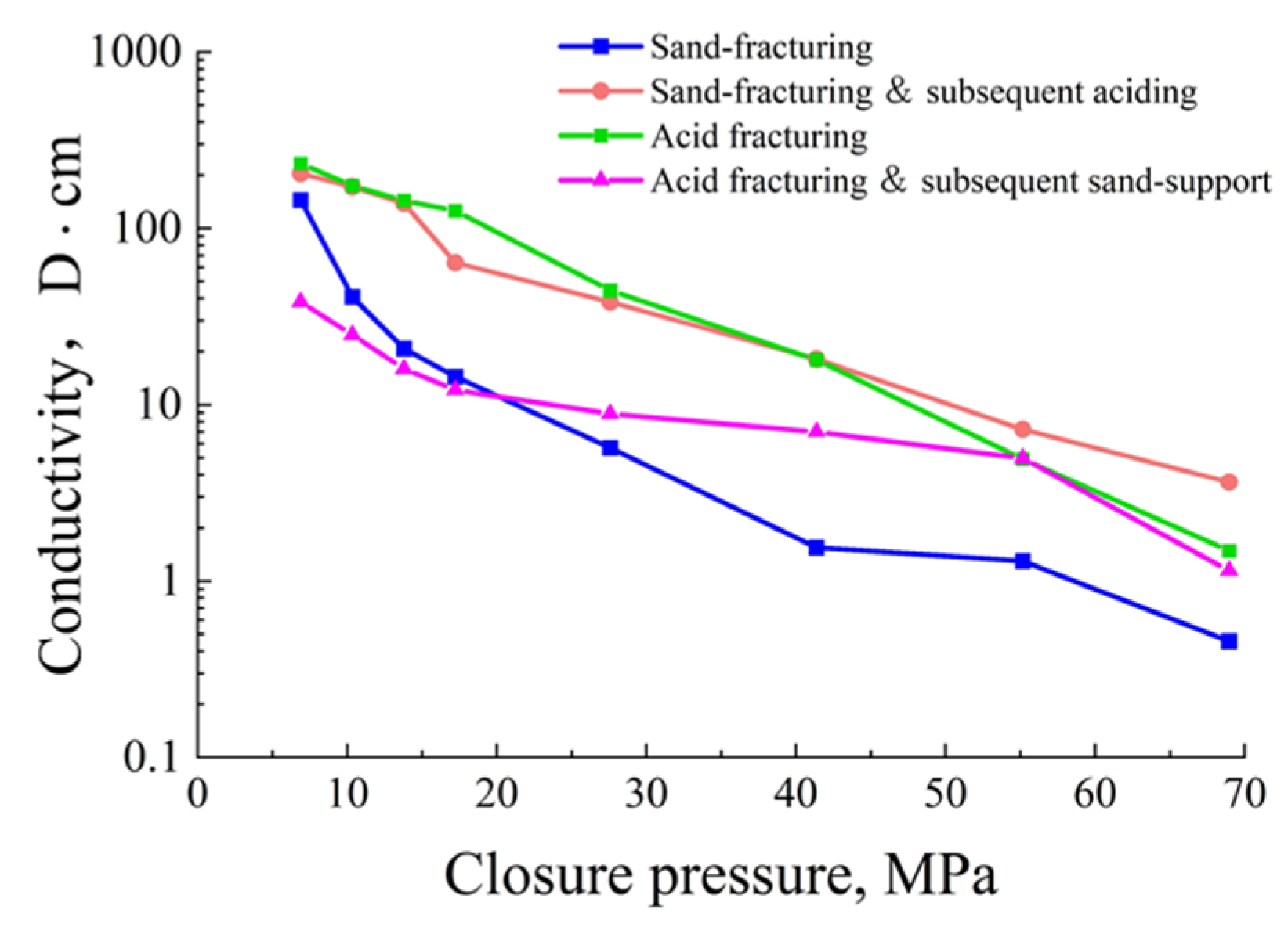
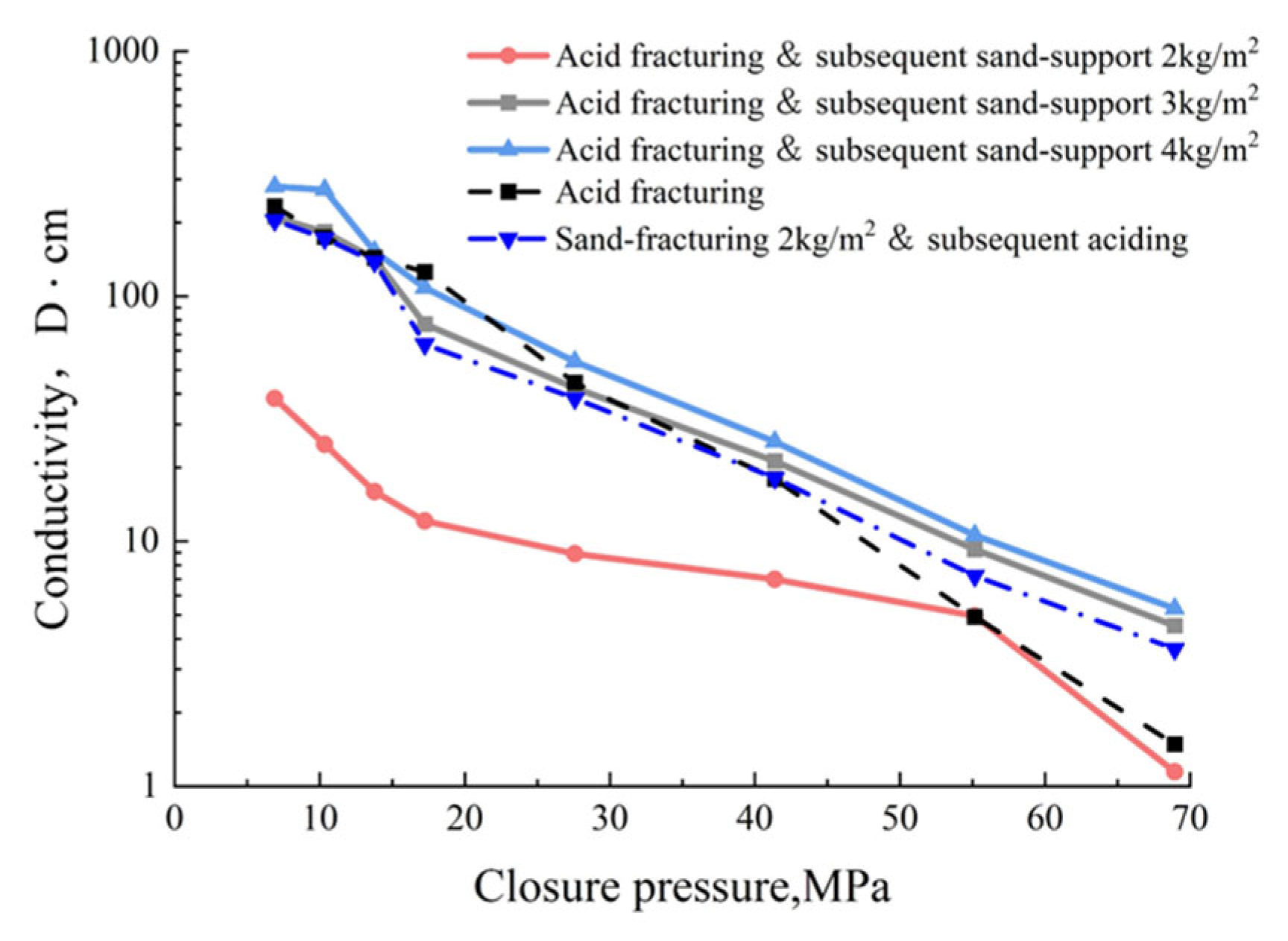
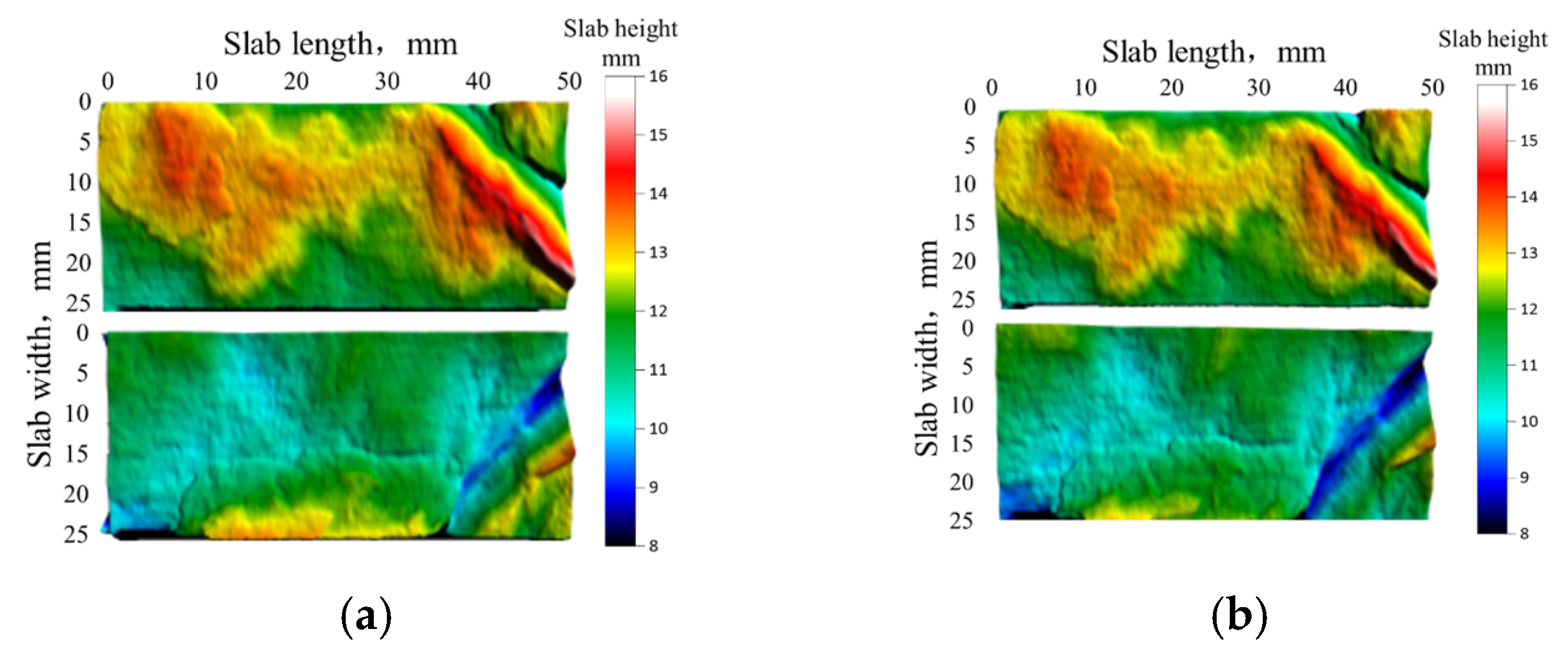
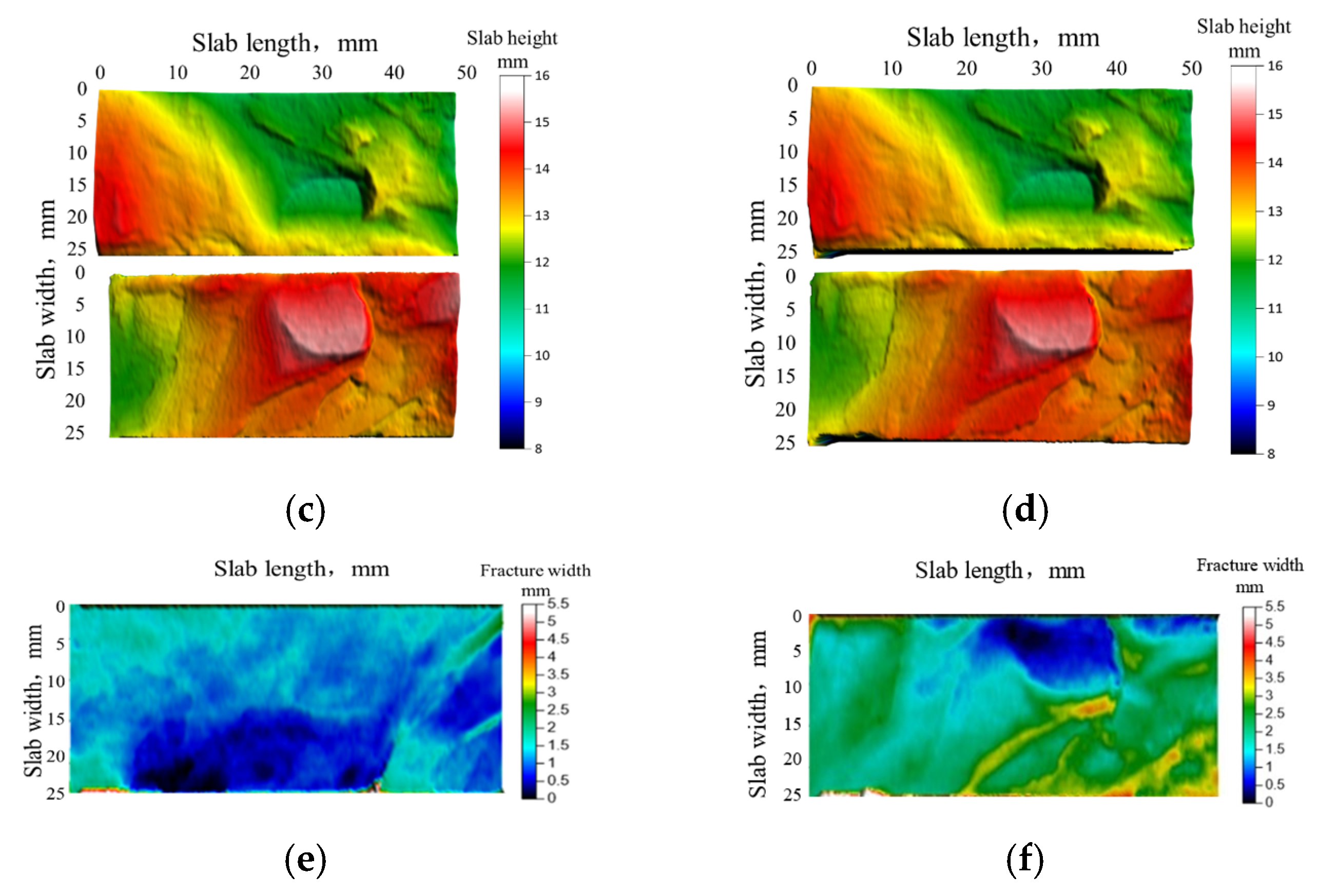
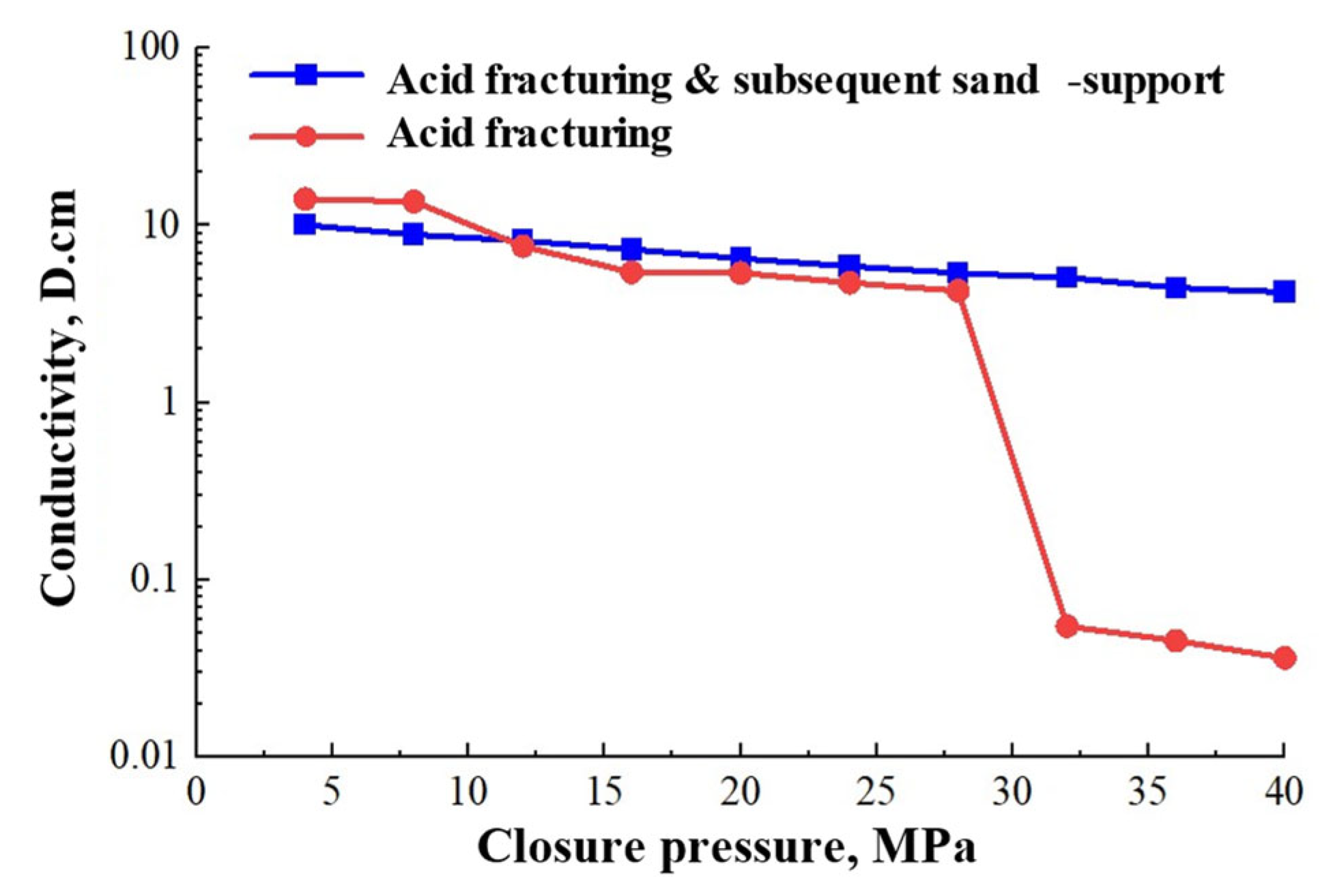

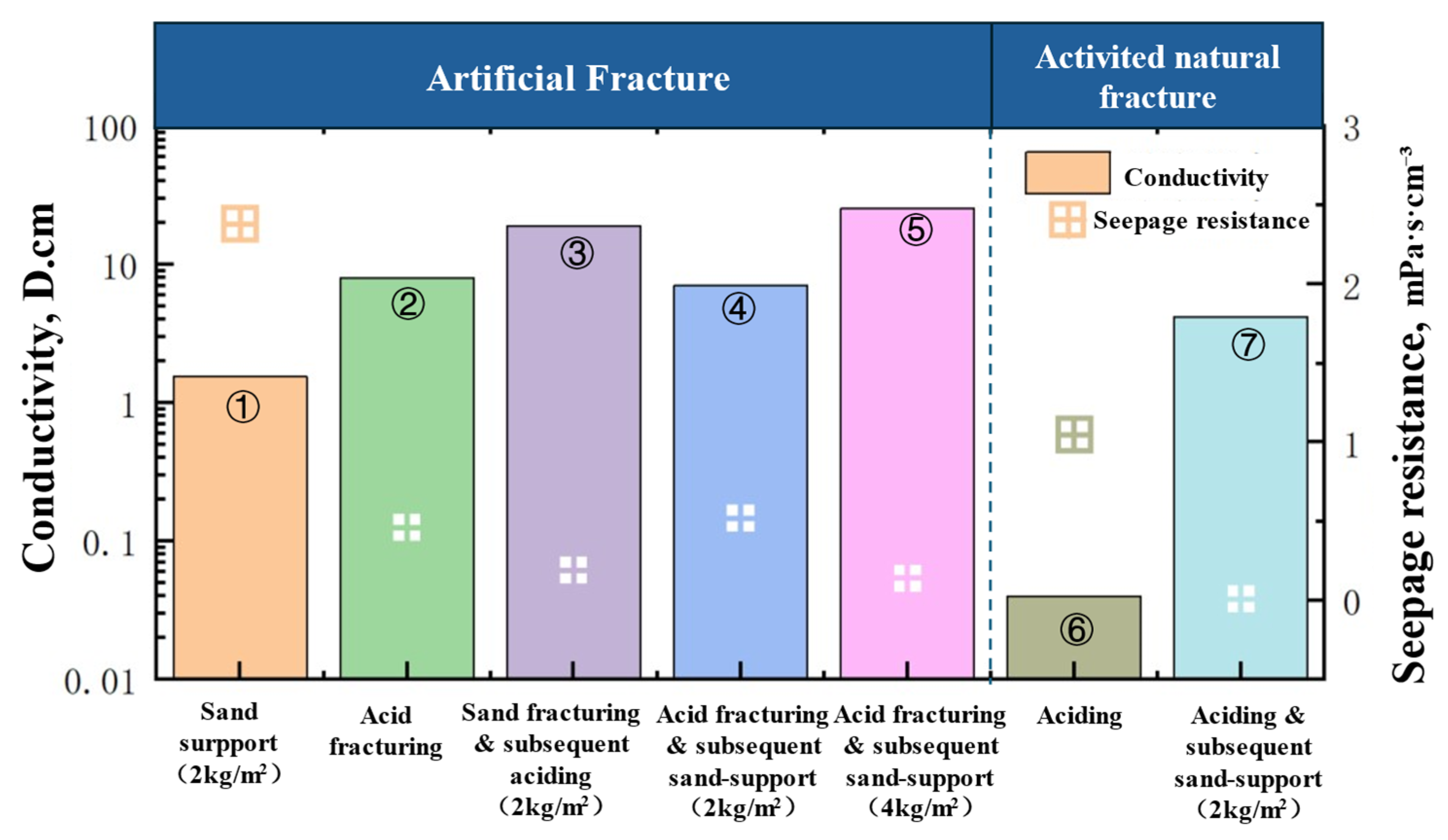
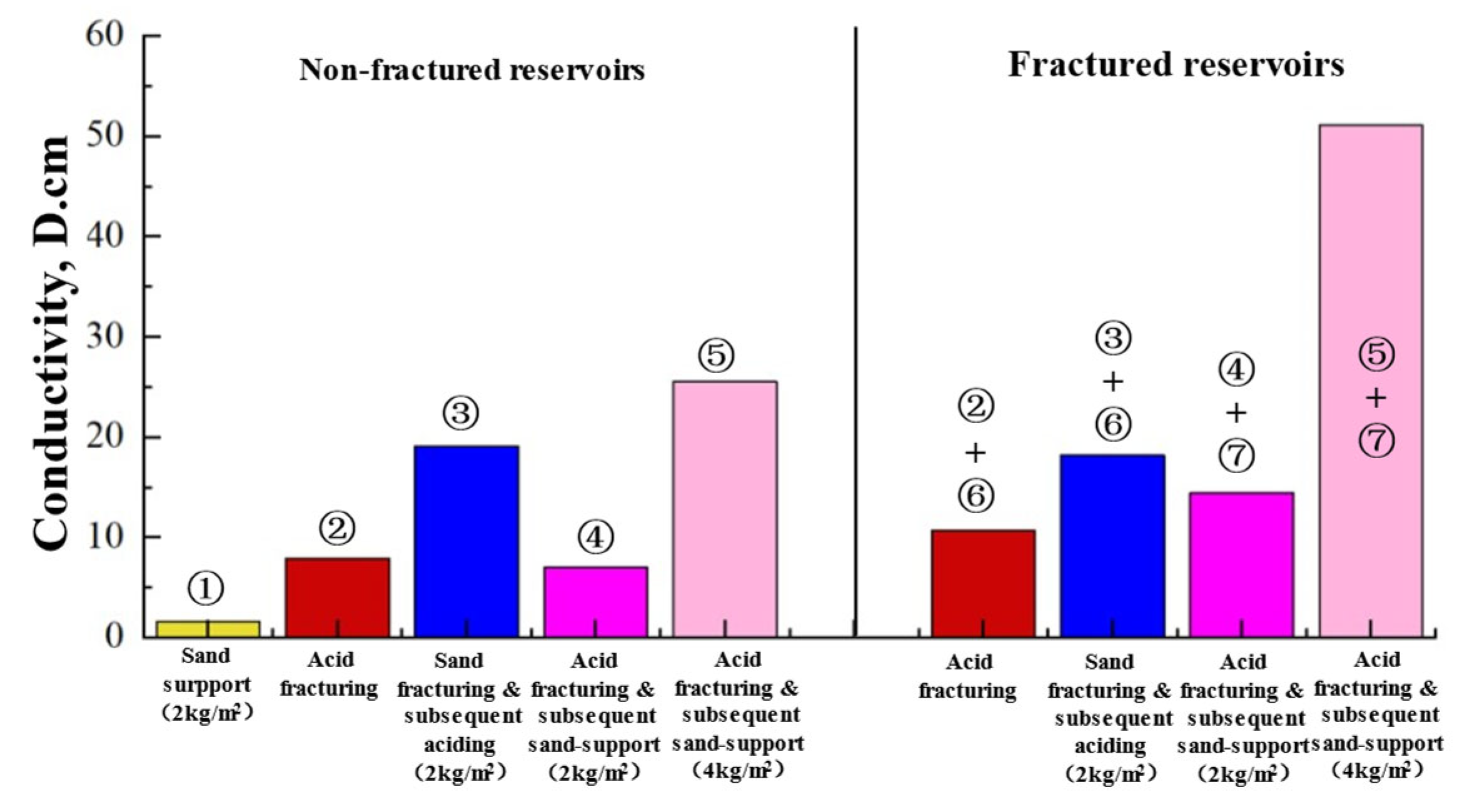
| No. | Clay (%) | Analcite (%) | Quartz (%) | Potassium Feldspar (%) | Plagioclase (%) | Calcite (%) |
|---|---|---|---|---|---|---|
| 1 | 4.5 | 0.0 | 29.0 | 16.3 | 24.8 | 25 |
| 2 | 18.7 | 2.7 | 43.2 | 8.4 | 12.3 | 15 |
| 3 | 15.5 | 15.3 | 37.9 | 19.4 | 11.2 | 1 |
| Liquid | Formula |
|---|---|
| Block HCl | 9% HCl + 2% clay stabilizer + 3.6% corrosion inhibitor + 0.5% discharge aid + 2% iron stabilizer + 0.3% resistance reducer |
| Mud acid | 9% HCl + 2% HF + 2% clay stabilizer + 3.6% corrosion inhibitor + 0.5% discharge aid + 2% iron stabilizer + 0.3% resistance reducer |
| Fracturing fluid | 0.45% Super guanidine gum + 0.5% discharge aid + 0.8% temperature stabilizer + 0.4% Crosslinking regulator + 2% clay stabilizer |
| qf (m3/min) | wf (m) | hf (m) | wl (m) | hl (m) | n | ql (mL/min) |
|---|---|---|---|---|---|---|
| 4 | 0.02 | 82 | 0.002 | 0.036 | 0.3 | 132 |
| Subject | No. | Production Process | Calcium Content (%) | Acid System | Temperature (°C) | Pumping Rate (mL/min) | Pumping Time (min) |
|---|---|---|---|---|---|---|---|
| The effect of calcium content | #1 | Acid fracturing | 25% | Block HCl | 90 | 132 | 30 |
| #2 | 15% | Block HCl | 90 | 132 | 30 | ||
| #3 | 1% | Block HCl | 90 | 132 | 30 | ||
| The influence of various production processes | #4 | Sand fracturing | 8% | Block HCl | 90 | 132 | 30 |
| #5 | Acid fracturing | 8% | Block HCl | 90 | 132 | 30 | |
| #6 | Acid fracturing and subsequent sand support | 8% | Block HCl | 90 | 132 | 30 | |
| #7 | Sand fracturing and subsequent acidizing | 8% | Block HCl | 90 | 132 | 30 |
| Natural Fracture Width (mm) | Fluid Pressure Difference on the Fracture Surface (MPa) | Fracture Normal Stiffness (MPa/mm) | The Width of Natural Fractures in the Experiment (mm) |
|---|---|---|---|
| 0.12 | 3.43 | 40 | 0.2 |
| qf (m3/min) | w0 (m) | L0 (m) | ρf (m−1) | D (m) | wln (m) | qln (mL/min) |
|---|---|---|---|---|---|---|
| 4 | 0.00012 | 4 | 1.6 | 0.025 | 0.0002 | 48 |
| Stimulation Techniques | No. | Acid System | Temperature (°C) | Pumping Rate (mL/min) | Pumping Time (min) |
|---|---|---|---|---|---|
| Acid fracturing | #1 | Block HCl | 90 | 48 | 30 |
| Acid fracturing | #2 | Mud acid | 90 | 48 | 30 |
| Acid fracturing and subsequent sand support | #3 | Mud acid | 90 | 48 | 30 |
Disclaimer/Publisher’s Note: The statements, opinions and data contained in all publications are solely those of the individual author(s) and contributor(s) and not of MDPI and/or the editor(s). MDPI and/or the editor(s) disclaim responsibility for any injury to people or property resulting from any ideas, methods, instructions or products referred to in the content. |
© 2025 by the authors. Licensee MDPI, Basel, Switzerland. This article is an open access article distributed under the terms and conditions of the Creative Commons Attribution (CC BY) license (https://creativecommons.org/licenses/by/4.0/).
Share and Cite
Peng, F.; Peng, J.; Zhou, J.; Liu, J.; Song, Q.; Xu, K.; Gou, B. The Conductivity of Combined Acid and Hydraulic Fracturing in the Fractured Tight Sandstone Reservoir: An Experimental Study. Processes 2025, 13, 2039. https://doi.org/10.3390/pr13072039
Peng F, Peng J, Zhou J, Liu J, Song Q, Xu K, Gou B. The Conductivity of Combined Acid and Hydraulic Fracturing in the Fractured Tight Sandstone Reservoir: An Experimental Study. Processes. 2025; 13(7):2039. https://doi.org/10.3390/pr13072039
Chicago/Turabian StylePeng, Fen, Jianxin Peng, Jianping Zhou, Junyan Liu, Qiuqiang Song, Ke Xu, and Bo Gou. 2025. "The Conductivity of Combined Acid and Hydraulic Fracturing in the Fractured Tight Sandstone Reservoir: An Experimental Study" Processes 13, no. 7: 2039. https://doi.org/10.3390/pr13072039
APA StylePeng, F., Peng, J., Zhou, J., Liu, J., Song, Q., Xu, K., & Gou, B. (2025). The Conductivity of Combined Acid and Hydraulic Fracturing in the Fractured Tight Sandstone Reservoir: An Experimental Study. Processes, 13(7), 2039. https://doi.org/10.3390/pr13072039





